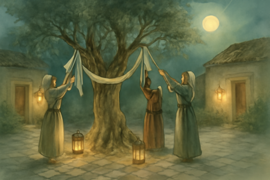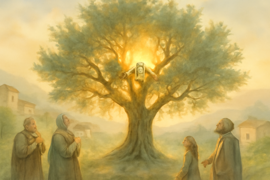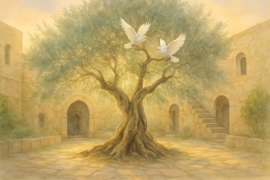Introduction
Beneath a sky brushed with hues of rose and amber, the city of Nablus drifted between dawn and daylight like a memory waking from sleep. Ancient stone walls, worn smooth by generations, caught the first golden rays of spring, setting the market’s mosaic of pottery and cloth aglow. In the heart of the town square stood the Olive of Hanan, its silver-green leaves swaying in a gentle breeze that carried the scent of jasmine and thyme. Villagers, young and old, paused in their morning routines to honor the tree’s twisting trunk, scarred with the letters of lovers past, and to whisper blessings for peace to come. They told of two pure white doves that, legend said, were once human hearts bound by a vow of devotion. With the air humming in anticipation, ears alert and eyes fixed aloft, they awaited the birds’ return—silent messengers of an ancient promise that love, like a seed, could endure the seasons of conflict and bloom once more with the warmth of spring.
1. The Legend Awakens
Long before the walls of Nablus were scarred by the echoes of conflict, the valley surrounding the city was a tapestry of olive groves and fragrant orchards. Among the villagers lived two young souls—Layla, the daughter of a potter whose hands shaped clay into vessels of humility, and Sami, a weaver whose loom danced with threads of crimson and gold. Their lives intertwined on market mornings, in the hush before dawn’s first caravan rattled through the gate. By the fountain’s edge, Layla’s laughter fell like blossoms in the water, and Sami’s heart, once heavy with the chores of his craft, found a rhythm in her song.

Their bond blossomed under the shadow of the Olive of Hanan, where whispered promises carved into bark bore witness to their vows. Layla fashioned a clay dove for Sami’s loom, painting each feather with care and sealing it with the name of the tree. Sami, in turn, wove a soft scarf of olive-green wool, a gift for Layla to wear when spring’s breeze turned cool at twilight. Each offering carried more than artistry; it carried devotion that glowed brighter than any gem in the caliph’s treasury.
IMAGE_PLACEHOLDER
But as spring dawned, a distant drumbeat of turmoil grew louder. Armies from rival lands pressed upon the valley’s borders, and the air quivered with the threat of siege. Elders counseled caution; families barred their doors; young men took up shields in defense. Sami stood beneath the olive tree, scarf wrapped tight around his neck, and Layla clung to the clay dove, tears reflecting hope and fear in equal measure. They vowed to reunite, their spirits entwined like olive branches despite the darkness rolling toward them.
The siege came with dusk’s betrayal and left in its wake a silence stitched with loss. The city gates, once welcoming, were now gates of shadows. By the tree, Layla and Sami’s gifts lay abandoned on the ground—clay shards and tangled wool—bearing silent testament to dreams unsettled by war. Yet, even in that ruined quiet, an unseen promise lingered: that devotion, once sown, would find the breath of life again when the earth warmed beyond sorrow’s winter.
2. The Trials of the Sacred Tree
As blades clashed beyond the city walls, the Olive of Hanan bore witness in solemn silence. Its trunk, knotted by centuries of seasons, drank the tears of villagers sheltering beneath its boughs. From time to time, a flash of white wings startled the sunbaked ground, but war’s thunder drowned even the wingbeats of hope. Amid the rubble and dust, whispers grew that a vow still lived, carried not in human hearts but in the song of doves destined to return.

Years passed, and the valley began to heal. Tent cities of displaced families gave way to terraces of jasmine and pomegranate, traders returned, and children again chased kites through the courtyard. Yet the Olive of Hanan, once crowned with radiant blossoms, now wore scars where arrows and fire had reached its weathered bark. Villagers gathered to tend its wounds—girdling the trunk with clay poultices, chanting prayers for renewal. In their voices trembled longing for the two doves, icons of a promise unbroken by war.
IMAGE_PLACEHOLDER
Song of the seasons moved forward, and with each dawn the townspeople scanned the sky. To their longing eyes, every drifting cloud became a wing, every coo in the distance a herald of reunion. But seasons came and went, and the olive tree stood bereft of its white guardians. Some whispered that Layla and Sami’s souls, too fragile for this world’s cruelties, had fled its branches forever. Yet an elder named Haj Muhammad insisted the promise slept like a seed under snow, waiting for the breath of love to thaw it once again.
With gentle counsel, he guided villagers to weave ribbons of white cloth into the branches and bury clay doves at the tree’s roots. He taught them that devotion wasn’t property of two lovers alone, but a gift to be shared among all who sought peace. The courtyard took on new life: feasts beneath lantern-lit boughs, children tracing the shapes of doves in the air, potters and weavers crafting tokens in memory of the lost couple. And as the olive branches trembled in the wind, the story of Layla and Sami passed from one eager voice to the next, a fragile hope ripening for the moment when spring would call it into flight.
3. Hope Returns in Spring
One morning, when the air hung with the promise of warmth, a gentle coo reached the ears of the village. Eyes lifted, breath caught—a lonely sound at first, then echoed in harmony. Two doves, plump and white as freshly fallen jasmine petals, glided down to the twisted boughs of the Olive of Hanan. The crowd held its breath as wings unfurled, talons touched worn wood, and the birds settled side by side as though no seasons had passed between their coming and their going.

A hush fell before a cry of joy burst forth. Elders wept, children laughed, and mothers pressed trembling hands to their hearts. The doves preened together, circling one another in a ritual as old as memory. Then, in the quiet that followed, they cooed—soft syllables like prayers uttered through feathers. From the clay dove buried at the roots sprouted a delicate blossom, white as dawn; from the cloth ribbons above fell a dusty petal that drifted to the ground like a blessing.
IMAGE_PLACEHOLDER
Among the throng, an old woman knelt, tracing the shape of Layla’s scarf woven into her shawl. In the soft hum of the gathering, she swore she heard the voices of the two young lovers carried in flight. Legends are born of memory and longing, she thought, but the flutter of fragile wings can make reality of our greatest hopes. The villagers tended the tree until each beat of a tiny heart against beak felt as precious as a drum heralding dawn.
In seasons that followed, the Two Doves of Nablus returned unwaveringly. Travelers came to witness the miracle; poets drank sweet wine beneath the blossoms; merchants carried stories of devotion through distant lands. And though the olive tree’s bark bore new scars of history, its branches were ever alive with the promise that no war, no winter of spirit, could sever the bonds drawn by a vow of love.
Today, when spring breathes its first warmth across the valley, ears keen for hope listen for that timeless coo. Two doves, guardians of a promise, wait among the olive leaves—you only need to look and believe.
Conclusion
When the sun climbs high over Nablus and the courtyard shimmers with midday heat, the Olive of Hanan stands as a living testament to devotion’s quiet power. Its trunk, forever marked by vows and prayers, bears witness to the cycles of loss and renewal that shape every human heart. The Two Doves, returning each spring without fail, bear a silent message carried on white wings: that even amid strife, love can root itself in broken soil and bloom again. Their coo is a gentle reminder to those who pause beneath the canopy of leaves, urging them to honor the promises woven into the fabric of their lives. For in a world that shifts on the edge of uncertainty, a single act of faith—like two hearts vowed beneath an olive tree—can ripple outward across time, carrying hope to distant fields and shared moments. In Nablus, the story lives in every blossom, every coo, every whispered vow, teaching each generation that a love tended with care will outlast the seasons of hardship and shine like an eternal spring within the soul of the city.

















